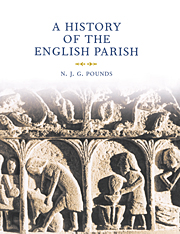Book contents
- Frontmatter
- Contents
- List of illustrations
- Preface
- List of abbreviations
- PART I THE ORIGINS OF THE PAROCHIAL SYSTEM
- 1 Church and parish
- 2 Rectors and vicars: from Gratian to the Reformation
- 3 The parish, its bounds and its divison
- 4 The urban parish
- PART II THE FUNCTIONS OF THE PARISH
- PART III THE PARISH AND ITS CHURCH
- Notes
- Index
3 - The parish, its bounds and its divison
Published online by Cambridge University Press: 29 July 2009
- Frontmatter
- Contents
- List of illustrations
- Preface
- List of abbreviations
- PART I THE ORIGINS OF THE PAROCHIAL SYSTEM
- 1 Church and parish
- 2 Rectors and vicars: from Gratian to the Reformation
- 3 The parish, its bounds and its divison
- 4 The urban parish
- PART II THE FUNCTIONS OF THE PARISH
- PART III THE PARISH AND ITS CHURCH
- Notes
- Index
Summary
Parishes were instituted for the ease and benefit of the
people, and not of the parson.
Chief Justice Lord HoltThe perambulations were not walked for XXX years by
reason whereof our bounds are lost.
Archdeacon's Visitation, 1589By the end of the twelfth century or early in the thirteenth at latest most of England was covered by a network of parishes, each with a centrally located church and generally accepted, if not precisely defined, boundaries. Where there remained a tract of unappropriated land between parishes this was because it was of little value and neither party had felt any great compulsion to claim it as its own. But this was to change. By the end of the Middle Ages such areas had been encroached upon, used for grazing, for felling timber and cutting peat and, above all, for settlement and cultivation. The history of the English landscape is in large measure that of the clearing and reclamation of the forest, marsh and waste. And as land came under some form of profitable use, so it became liable to the payment of tithe to one parish or the other. Most parish boundaries were prescriptive; they had been established at an early date and in many instances had coincided with the limits of some form of secular authority. Indeed, there is abundant evidence that many parishes conformed wholly or in part with the lands of the thegns or lords who had founded and endowed their churches.
- Type
- Chapter
- Information
- A History of the English ParishThe Culture of Religion from Augustine to Victoria, pp. 67 - 112Publisher: Cambridge University PressPrint publication year: 2000



